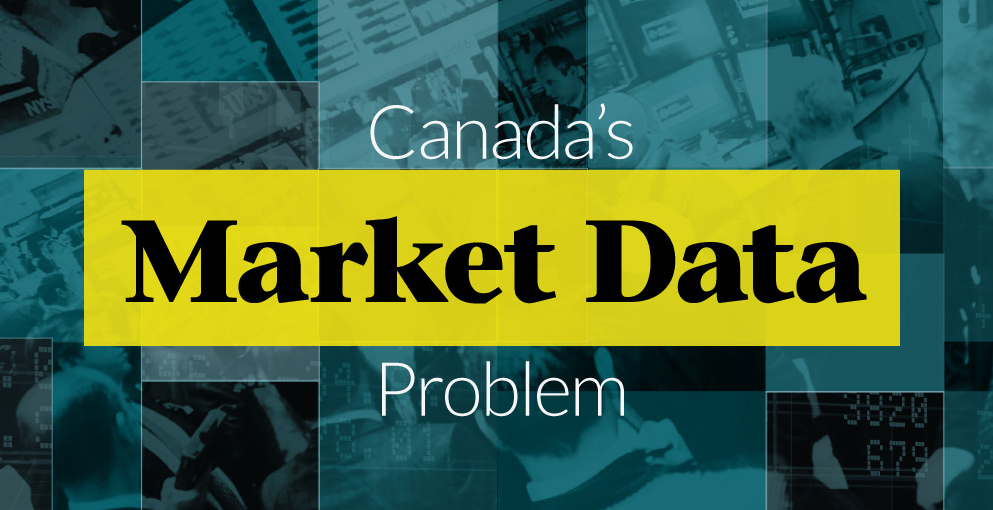Information is what allows buyers and sellers to make decisions in the market. However, if that information is inaccurate or incomplete, it can impact the health of the market.
Information Failure
Today’s infographic from the Aequitas NEO Exchange details the current “information failure” that is happening in the Canadian market. What’s information failure? It’s when some, or all, of the participants in an economic exchange do not have perfect knowledge. This leads to a misallocation of scarce resources and it appears to exist in numerous market exchanges. In the case of securities in Canada, the problem arises from the market data that investors are using to make buying and selling decisions.
Canada’s Market Data Landscape
Market data is simply the information that investors see when buying or selling a security – for example, prices (bid, ask) or liquidity indicators (volume, market depth). Aside from the TSX itself, there are 13 other trading platforms that facilitate the buying and selling of securities in Canada. These range from exchanges (like the CSE or Aequitas NEO Exchange) to more proprietary platforms (Instinet or Liquidnet) which are used primarily by institutions. Either way, trading is being done across all these platforms each day, and each exchange generates its own market data on prices and liquidity. The problem? Many investors only see just part of the whole picture. For example, retail investors that buy through an online brokerage account may only see data from the TSX and TSX-V, which together account for about 59% of volume traded (as of Q4 2016).
The Consequences
By only accessing partial market data, the true liquidity or price of a security may not be accurately represented. Here’s an example of how this unfolds in real life:
An investment advisor wants to buy a particular ETF for a client. A partial view of the market might mean that the security looks less liquid than it actually is. As a result, the advisor may choose to put the client in a different, less optimal fund.
Here’s another example:
An investor is considering several companies in which to invest. A partial view of market activity can result in companies appearing more, or less, attractive than others. Uninformed investment decisions lead to less optimal investments and the potential misallocation of capital.
In other words, information failure can affect investors and their portfolios directly – and can result in important consequences. on The good news is that the Federal Reserve, U.S. Treasury, and Federal Deposit Insurance Corporation are taking action to restore confidence and take the appropriate measures to help provide stability in the market. With this in mind, the above infographic from New York Life Investments looks at the factors that impact bonds, how different types of bonds have historically performed across market environments, and the current bond market volatility in a broader context.
Bond Market Returns
Bonds had a historic year in 2022, posting one of the worst returns ever recorded. As interest rates rose at the fastest pace in 40 years, it pushed bond prices lower due to their inverse relationship. In a rare year, bonds dropped 13%.
Source: FactSet, 01/02/2023.
Bond prices are only one part of a bond’s total return—the other looks at the income a bond provides. As interest rates have increased in the last year, it has driven higher bond yields in 2023.
Source: YCharts, 3/20/2023.
With this recent performance in mind, let’s look at some other key factors that impact the bond market.
Factors Impacting Bond Markets
Interest rates play a central role in bond market dynamics. This is because they affect a bond’s price. When rates are rising, existing bonds with lower rates are less valuable and prices decline. When rates are dropping, existing bonds with higher rates are more valuable and their prices rise. In March, the Federal Reserve raised rates 25 basis points to fall within the 4.75%-5.00% range, a level not seen since September 2007. Here are projections for where the federal funds rate is headed in 2023:
Federal Reserve Projection*: 5.1% Economist Projections**: 5.3%
*Based on median estimates in the March summary of quarterly economic projections.**Projections based on March 10-15 Bloomberg economist survey. Together, interest rates and the macroenvironment can have a positive or negative effect on bonds.
Positive
Here are three variables that may affect bond prices in a positive direction:
Lower Inflation: Reduces likelihood of interest rate hikes. Lower Interest Rates: When rates are falling, bond prices are typically higher. Recession: Can prompt a cut in interest rates, boosting bond prices.
Negative
On the other hand, here are variables that may negatively impact bond prices:
Higher Inflation: Can increase the likelihood of the Federal Reserve to raise interest rates. Rising Interest Rates: Interest rate hikes lead bond prices to fall. Weaker Fundamentals: When a bond’s credit risk gets worse, its price can drop. Credit risk indicates the chance of a default, the risk of a bond issuer not making interest payments within a given time period.
Bonds have been impacted by these negative factors since inflation started rising in March 2021.
Fixed Income Opportunities
Below, we show the types of bonds that have had the best performance during rising rates and recessions.
Source: Derek Horstmeyer, George Mason University 12/3/2022. As we can see, U.S. ultrashort bonds performed the best during rising rates. Mortgage bonds outperformed during recessions, averaging 11.4% returns, but with higher volatility. U.S. long-term bonds had 7.7% average returns, the best across all market conditions. In fact, they were also a close second during recessions. When rates are rising, ultrashort bonds allow investors to capture higher rates when they mature, often with lower historical volatility.
A Closer Look at Bond Market Volatility
While bond market volatility has jumped this year, current dislocations may provide investment opportunities. Bond dislocations allow investors to buy at lower prices, factoring in that the fundamental quality of the bond remains strong. With this in mind, here are two areas of the bond market that may provide opportunities for investors:
Investment-Grade Corporate Bonds: Higher credit quality makes them potentially less vulnerable to increasing interest rates. Intermediate Bonds (2-10 Years): Allow investors to lock in higher rates.
Both types of bonds focus on quality and capturing higher yields when faced with challenging market conditions.
Finding the Upside
Much of the volatility seen in the banking sector was due to banks buying bonds during the pandemic—or even earlier—at a time when interest rates were historically low. Since then, rates have climbed considerably. Should rates moderate or stop increasing, this may present better market conditions for bonds. In this way, today’s steep discount in bond markets may present an attractive opportunity for price appreciation. At the same time, investors can potentially lock in strong yields as inflation may subside in the coming years ahead. Learn more about bond investing strategies with New York Life Investments.




























